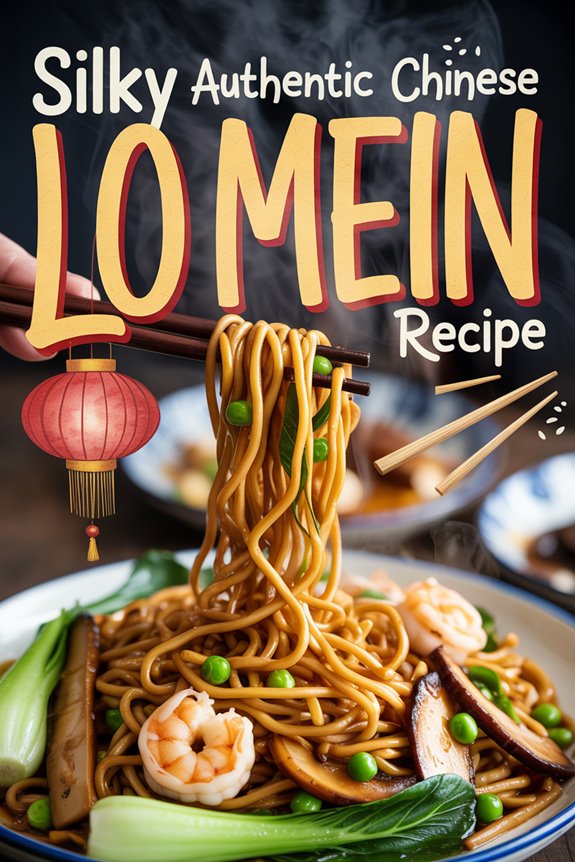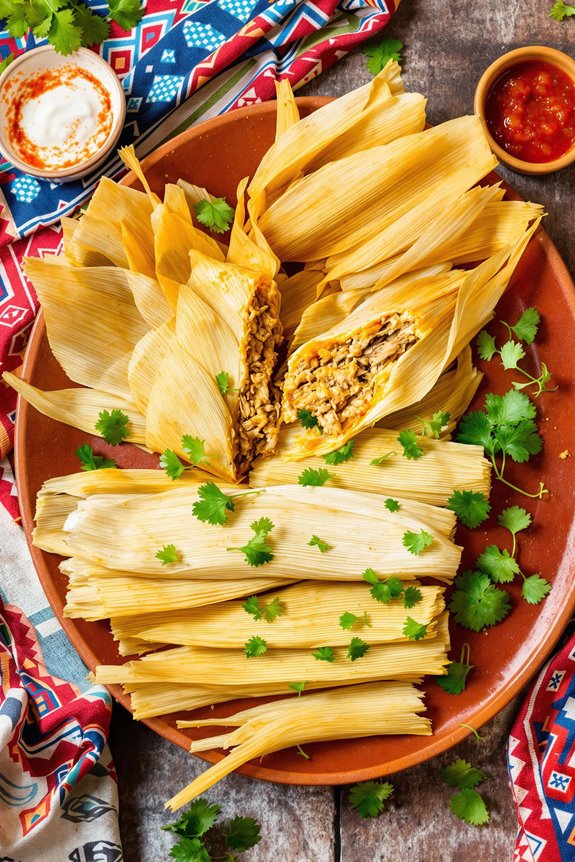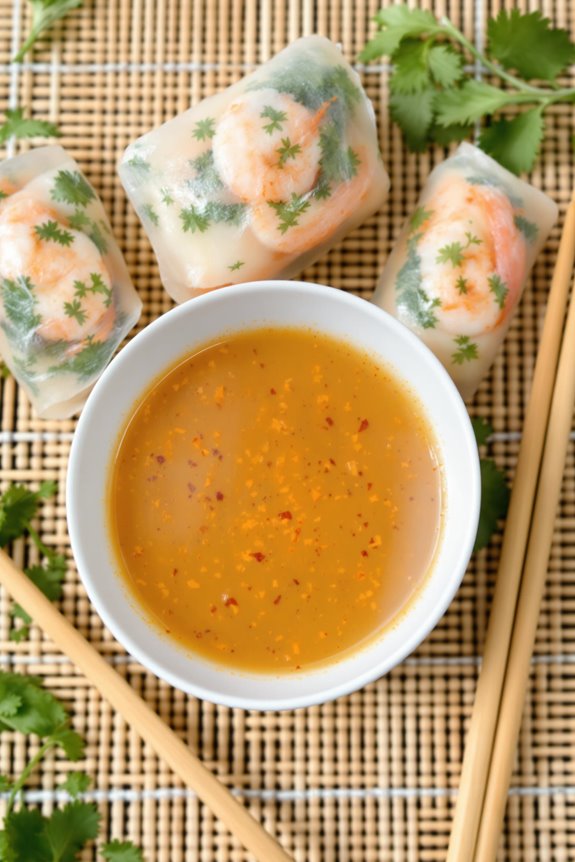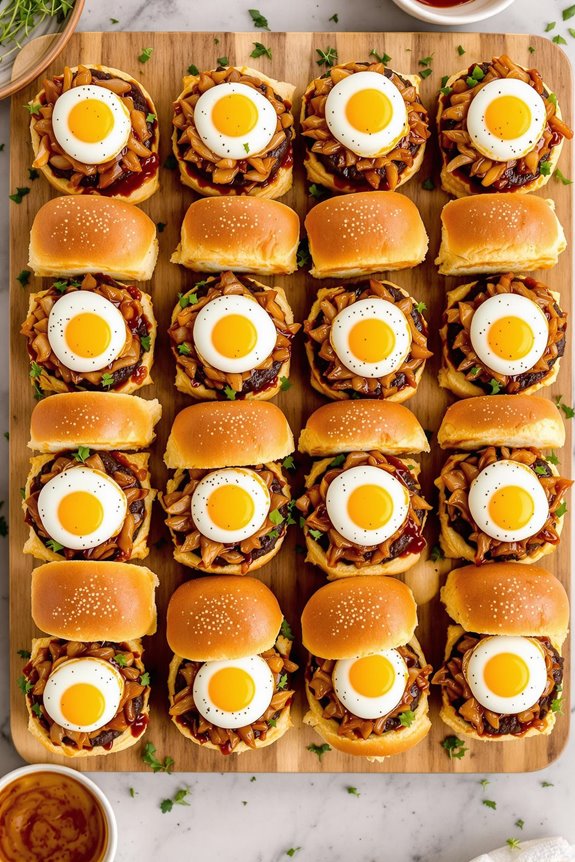Links below are affiliate links. We earn a commission on purchases at no extra cost to you.
Silky Authentic Chinese Lo Mein Noodles Recipe
Savor silky Chinese lo mein noodles with shrimp and aromatic seasonings that rival your favorite restaurant's version without the wait.
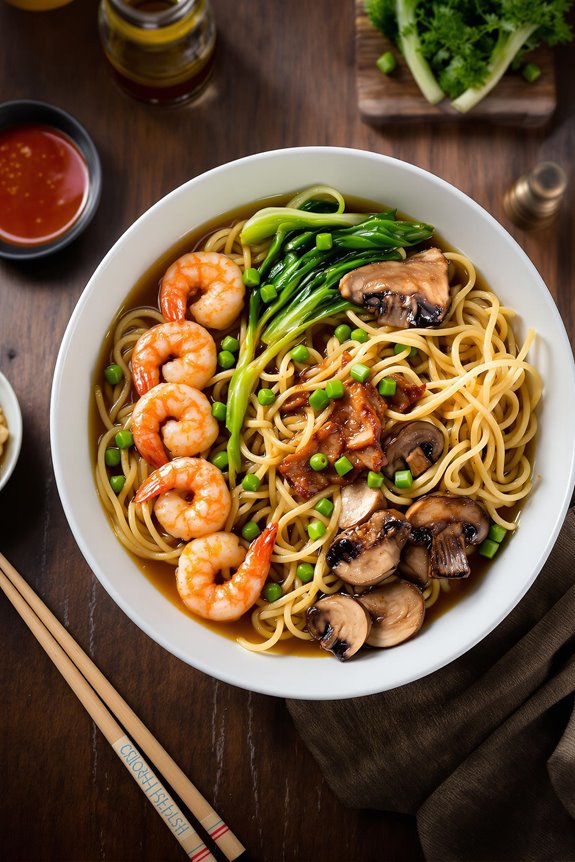
Why You’ll Love these Chinese Lo Mein Noodles
If you’re looking for a restaurant-quality dish that can be made right in your own kitchen, you’ll absolutely fall in love with these Chinese Lo Mein noodles.
The silky egg noodles wrapped in that savory oyster sauce-based coating create the perfect canvas for tender shrimp, crisp vegetables, and smoky barbecued pork.
What I adore about this recipe is its perfect balance of textures—crunchy pea pods, tender bok choy, meaty mushrooms—all tossed with that signature Lo Mein chew.
The aromatics of fresh ginger and garlic will transform your kitchen into your favorite Chinese restaurant, minus the wait time or delivery fees!
What Ingredients are in Chinese Lo Mein Noodles?
When I think about making restaurant-quality Chinese Lo Mein at home, I’m always amazed by how the right combination of ingredients creates that authentic flavor we all crave. This shrimp and barbecued pork Lo Mein recipe brings together the perfect blend of proteins, vegetables, noodles, and aromatics, all coated in a rich, savory sauce that clings beautifully to every strand of noodle.
The ingredient list might look lengthy at first glance, but most items are staples in Asian cooking that you’ll use again and again.
- 3/4 pound fresh or frozen shrimp
- 8 ounces Chinese egg noodles
- 1 cup barbecued pork, sliced
- 8 ounces bok choy (about 4 large stalks)
- 6 ounces pea pods
- 4 ounces mushrooms
- 2 green onions
- 1 teaspoon chopped gingerroot
- 1 teaspoon finely chopped garlic
- 1/4 cup oyster sauce
- 1 cup chicken broth
- 4 tablespoons vegetable oil (divided)
- 4 tablespoons cornstarch (divided)
- 1/2 teaspoon sesame oil
- 1-1/4 teaspoons salt (divided)
- 1/8 teaspoon white pepper
- 3 tablespoons cold water
Don’t be tempted to substitute regular Italian pasta for the Chinese egg noodles—they’re really the heart of this dish and provide that distinctive chewy texture that makes Lo Mein so satisfying.
For the barbecued pork, you can find char siu at Asian markets, or you can use leftover Chinese takeout roast pork if you have it. The oyster sauce is another non-negotiable ingredient that gives the dish its characteristic umami depth.
If you’re sensitive to seafood allergies, you could substitute the shrimp with chicken, but the combination of both shrimp and pork really elevates this dish to restaurant quality.
And remember, the vegetables can be somewhat flexible based on what’s fresh and available—just keep the proportions similar for that perfect balance of noodles to protein to veggies.
How to Make these Chinese Lo Mein Noodles
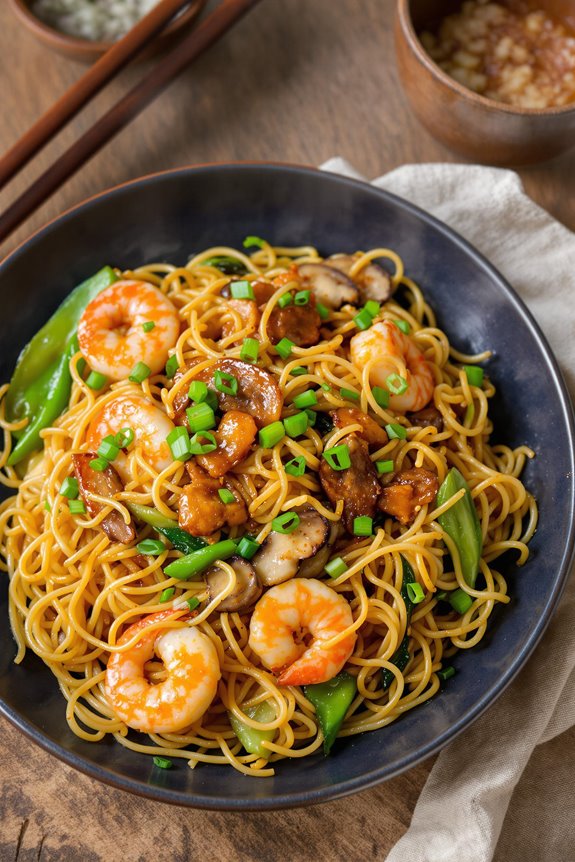
To prepare this delicious lo mein, start by preparing your shrimp and vegetables. Peel 3/4 pound of shrimp (if they’re frozen, peel them under cold running water), remove the sand vein with a shallow cut, and slice them lengthwise into halves. Toss the shrimp with 1 teaspoon cornstarch, 1/2 teaspoon sesame oil, 1/4 teaspoon salt, and 1/8 teaspoon white pepper, then refrigerate for 20 minutes.
Meanwhile, prep your vegetables – separate bok choy leaves from stems and cut accordingly, blanch 6 ounces of pea pods in boiling water for just a minute before cooling them under cold water, slice 4 ounces of mushrooms, and cut 2 green onions into 2-inch pieces.
Now for the cooking process, which moves rather quickly once you start. Cook 8 ounces of Chinese egg noodles in boiling water for about 5 minutes until soft and separable, then drain and keep warm in a 300°F oven.
Heat your wok until it’s properly hot (you can test with water droplets that should bubble and skitter), add 2 tablespoons of vegetable oil, and stir-fry the shrimp with 1 teaspoon each of chopped gingerroot and garlic until the shrimp turns pink. Remove the shrimp, add another 2 tablespoons of oil, and stir-fry the bok choy stems for a minute before adding the leaves, mushrooms, 1/4 cup oyster sauce, and 1 teaspoon salt.
After another minute of stir-frying, add 1 cup chicken broth and bring to a boil. The sauce gets thickened with a mixture of 3 tablespoons cornstarch and 3 tablespoons cold water, which transforms the dish in seconds.
For the most consistent texture in your sauce and perfectly minced aromatics, using a high end food processor can significantly streamline your preparation time.
Finally, return the shrimp to the wok along with the pea pods, green onions, and 1 cup of sliced barbecued pork, cooking for just 30 seconds more before serving this flavorful mixture over the warm noodles.
Chinese Lo Mein Noodles Substitutions and Variations
This classic lo mein recipe is wonderfully adaptable, allowing you to customize it based on what’s in your refrigerator or your personal preferences.
You can swap the shrimp for chicken, beef, or tofu if you’re going vegetarian. Don’t have bok choy? Baby spinach or napa cabbage work beautifully.
The mushrooms are flexible too—shiitakes offer earthier flavor than button mushrooms, while oyster mushrooms provide delicate texture.
For the noodles, if you can’t find Chinese egg noodles, ramen or even spaghetti will do in a pinch (I won’t tell the purists!).
The oyster sauce is pretty essential, but hoisin mixed with soy sauce creates a decent substitute.
What to Serve with Chinese Lo Mein Noodles
Although lo mein can certainly stand on its own as a complete meal, pairing it with complementary side dishes creates a more authentic Chinese dining experience that I’m always enthusiastic to share.
I recommend serving spring rolls or potstickers as appetizers—their crispy textures contrast beautifully with the silky noodles. A simple cucumber salad with rice vinegar and sesame oil offers invigorating acidity that cuts through the richness.
For beverages, jasmine tea or a light lager works perfectly. If you’re feeling ambitious, finish with almond cookies or mango pudding for dessert.
The key is balance: something crunchy, something fresh, and something sweet.
Final Thoughts
While mastering Chinese lo mein might seem intimidating at first, I’ve found that the magic lies in preparation and timing. The key is mise en place—having everything chopped, mixed, and ready before you heat that wok.
There’s something deeply satisfying about watching shrimp turn pink while ginger and garlic perfume your kitchen, followed by the quick dance of vegetables finding their perfect tenderness.
What I love most about lo mein is its versatility. Don’t have bok choy? Substitute spinach. No pork? Try chicken or tofu.
Trust your instincts, taste as you go, and remember—the noodles should glisten, not swim.

